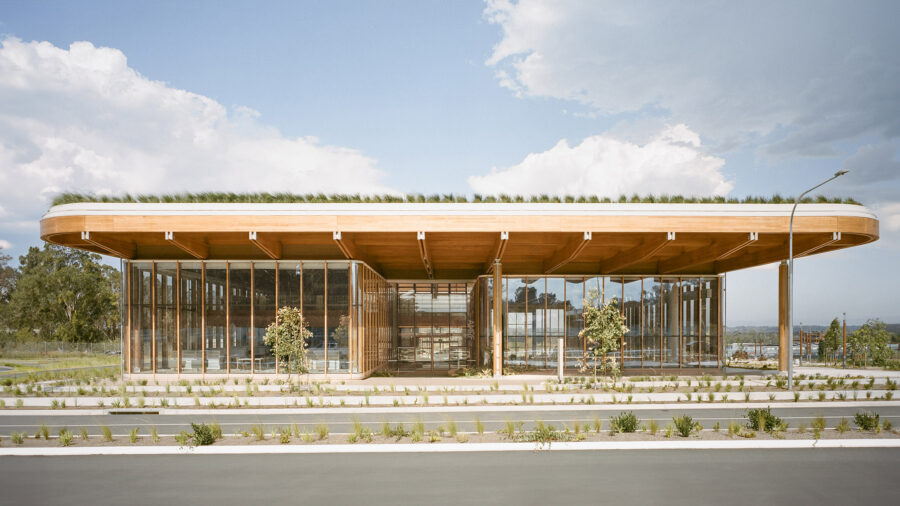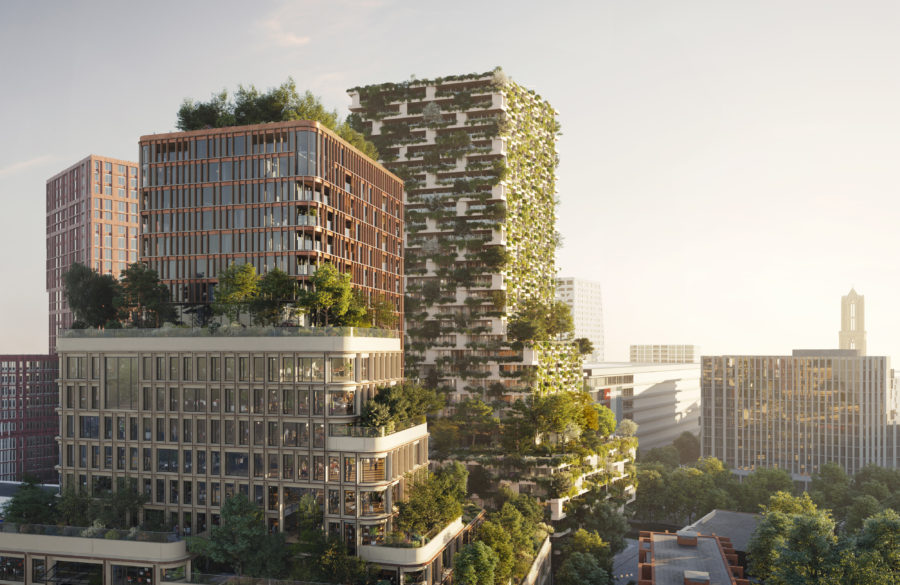
CULTURE


©︎ Thea van den Heuvel
歴史ある運河に架かる、世界初のステンレス鋼3Dプリント橋〈MX3D Bridge〉が、2021年7月15日にオランダ・アムステルダムにて公開されました。金属による3Dプリント技術を提供するオランダの企業、MX3Dが作成したスマートブリッジです。
3Dプリントやロボットアームを活用したプロジェクトを多く手掛けるジョリス・ラーマン・ラボ(Joris Laarman Lab)が設計し、国際的なエンジニアリング・コンサルティング企業であるArupがリードエンジニアを務めたプロジェクトです。

©︎ Adriaande Groot
(以下、MX3Dから提供されたテキストの抄訳)
デジタルツールが建築物の新たなデザイン言語となることを示す、遊び心と刺激に満ちた事例を作成するため、MX3Dは大規模ロボット3Dプリント技術で金属の橋を作成するプロジェクトを開始した。〈MX3D Bridge〉の設置は、2015年に始動したこのプロジェクトの集大成である。

©︎ Thijs Wolzak
このプロジェクトは、ABB、Air Liquide、ArcelorMittal、Autodesk、AMS Institute、Lenovoといったさまざまな業界リーダーとのコラボレーションによって実現している。
このコラボレーションにより、2017年から2018年にかけて、4台のロボットが6,000kg以上のステンレス鋼を使って〈MX3D Bridge〉を3Dプリントしたのである。

©︎ Jande Groen
MX3Dのもつ独自の3Dプリント技術は、既製品の溶接ロボットを使用し、金属製のオブジェクトを層状に作成するものである。
〈MX3D Bridge〉のデザインは、ジェネレーティブデザインとトポロジー最適化技術を用いて作成された。これらのテクノロジーを組み合わせることで、より高い自由度と大幅な材料削減を実現している。

©︎ Jande Groen
「生きた実験室」としてのスマートブリッジ
〈MX3D Bridge〉は、最先端のセンサネットワークを備えた「スマートブリッジ」である。
アムステルダム市は研究者とともに、センサから得られたデータを活用し、建築環境におけるIoTシステムの可能性を探っている。

©︎ Thijs Wolzak
例えば、このシステムを使うことで、人々の行動を匿名で分析し、橋の設置されたレッドライト地区の観光の影響をよりよく理解することが可能となるかもしれない。
また、このプロジェクトは、オープンデータやデータ倫理といった問題にも取り組んでおり、これらの目的から、〈MX3D Bridge〉はアムステルダム市から2年間の設置許可を得ている。

©︎ Joris Laarman Lab
スマートセンサーネットワークで実現する「デジタルツイン」
このビジョンを実現するためには、MX3D、アラン・チューリング研究所(Alan Turing Institute)、Arup、Autodesk、FORCE Technology、トゥウェンテ大学による幅広いコラボレーションが必要となった。

©︎ Joris Laarman Lab

©︎ Joris Laarman Lab
このコラボレーションにより3年をかけて構築された高度なセンサーネットワークは、リアルタイムでデータを収集し、データをライブモデルで視覚化、そのデータ上に有用な分析を作成し、〈MX3D Bridge〉のデジタルツインに反映させることに成功した。

©︎ Arup

©︎ Arup
センサは、ひずみ、回転、荷重、変位、振動といった構造的な数値や、大気質や温度などの環境要因も測定しており、このデータを用いて、実物の状況をリアルタイムで反映した正確なコンピュータモデルである「デジタルツイン」を作成している。
デジタルツインは、エンジニアが橋の健康状態を測定し、橋の寿命がどのように変化するかをモニターするのに役立っている。
また、橋を渡る人の数や速度などを測定したセンサのデータは、橋の上で起こっている現象を理解するためにも使われている。

©︎ Adriaan de Groot
データを視覚化するAutodeskのシステム
プロジェクトの立ち上げから協力しているAutodeskの研究者チームは、特注のソフトウェアを設計し、システムの構築・運用などを請け負うシステムインテグレータを務めた。
Autodeskは、アラン・チューリング研究所やFORCE Technology、トゥウェンテ大学と連携し、センサネットワークの設計と設置を行った。

©︎ Adriaan de Groot

©︎ Adriaan de Groot
Autodeskのソフトウェアは、センサネットワークからデータを収集し、〈MX3D Bridge〉の利用状況と反応をデジタルツインモデルでリアルタイムに視覚化している。
このソフトウェアは試作段階に行った構造試験においても役に立ち、荷重試験と材料試験の結果、設計荷重を大きく上回る19.5トンの荷重を保持できることが証明された。

©︎ Olivier de Gruijter

©︎ Olivier de Gruijter
データを倫理的に活用し、デジタルツインを進化させるアラン・チューリング研究所
イギリスの国立研究所であるアラン・チューリング研究所は、データサイエンスとAIの専門家を集めたチームを編成し、このプロジェクトとのコラボレーションを開始した。
アラン・チューリング研究所は、〈MX3D Bridge〉が設置されている2年間における橋のデータをホストしており、プロジェクトの科学的目標が人々のプライバシーを損なうことがないよう、徹底した倫理審査を行っている。

©︎ Joris Laarman Lab

©︎ Olivier de Gruijter
また、カスタムデータプラットフォームを使用した、安全なクラウドを提供し、保存されたセンサデータへのアクセスを必要とする研究者をサポートしている。
アラン・チューリング研究所の研究者は、〈MX3D Bridge〉の高度なデジタルツインモデルを開発する専門知識を持ち、現在、これらの知見を応用して、橋のデジタルツインを進化させている。

©︎ Olivier de Gruijter

©︎ Olivier de Gruijter
イノベーションを実現するための行政の役割
世界中でスマートシティの構築が進む中、〈MX3D Bridge〉のような研究プロジェクトは、専門家が3Dプリント構造物やIoTシステムの設計、運用、安全性を向上させるのに役立つものである。

©︎ Olivier de Gruijter
このプロジェクトにおいてアムステルダム市は、行政が新たなテクノロジーの導入における「ファシリテーター」として機能することの重要性を示している。
行政の積極的なファシリテーションは、MX3Dとその製品である、溶接ロボットをハイエンドな3Dメタルプリンタに変えるソフトウェアの世界的な成功における大きな要因の1つである。

©︎ Adriaan de Groot
イノベーションにおける障壁、変更とこれから
〈MX3D Bridge〉のような画期的なプロジェクトは、必然的に障壁や予期せぬ変更に遭遇するものである。
当初の設計コンセプトは工学的な懸念から大幅に変更され、当初予定されていた現地での3Dプリントは、安全性と技術的な懸念から実現不可能であることが判明した。さまざまな変更により、プロジェクトの完成まで2年近く延期することとなった。

©︎ Merlin Moritz
今回のプロジェクトと並行して、MX3Dのエンジニアは、「ロボットが自律的にインフラを3Dプリントする」というビジョンを実現するための作業を続けており、ロボットが橋の上に置かれた状態で、自分の位置を把握してプリントすることに成功している。
これはMX3Dのビジョンを実証するものであり、ロボットが人間の手を借りずに橋を3Dプリントすることは、もはやフィクションではないことを示しているのである。

©︎ Adriaan de Groot
以下、MX3Dのリリース(英文)です。
-Press Release MX3D Bridge-
MX3D’s Smart BRIDGE unveiled by Robot in Amsterdam’s city center
MX3D Bridge is now ready to use
World premiere: Her Majesty the Queen of the Netherlands, Máxima, opens the first 3D printed steel bridge in the oldest neighbourhood of Amsterdam.
Amsterdam, 15-07-2021 – Dutch technology scale up MX3D today unveiled the world’s first stainless steel 3D printed bridge in the city center of Amsterdam.
The futuristic multi award-winning bridge, designed by Joris Laarman Lab with Arup as lead engineer, will be placed over one of the oldest canals in Amsterdam’s Red light district. The installation of the bridge is the culmination of several years of work. MX3D kicked off this project in 2015 when it proposed printing a metal bridge with its innovative large-scale, robotic 3D printing technology, creating a playful, inspiring example of how digital tools can create a new form language for architectural objects.
“The Bridge is only the beginning for our technology, by now MX3D has introduced its metal printing tool on the industrial market, and with this tool already many companies have started printing like us. I am looking forward to all positive impact and new ideas our client will realize”, Says Gijs van der Velden, CEO MX3D
The project was brought to life thanks to funding of the Lloyd’s Register Foundation and the collaboration with a range of industry leaders including ABB, Air Liquide, ArcelorMittal, Autodesk, AMS Institute and Lenovo, which all have helped MX3D realise its bold, ambitious vision.
This collaborative effort saw the bridge brought to life between 2017-2018, when four robots 3D printed the structure using more than 6,000 kgs of stainless steel. The City of Amsterdam granted MX3D bridge a two-year permit.
The proprietary MX3D printing technology uses off the shelf welding robots to build up metal objects layer by layer. The MX3D bridge design was created using generative design and topology optimisation techniques. The combination of those technologies allow for a higher form of liberty and a promise of significant material reduction.
Smart MX3D bridge is a ‘living laboratory’
Innovative in design and technology, the bridge serves as a living laboratory. Equipped with a state-of-the-art sensor network, the ‘Smart Bridge’ is powering a cutting edge research project. In concert with academic and industry researchers the City of Amsterdam will use the bridge’s data streams to explore the role of IoT systems in the built environment. For instance: can we use such systems to anonymously analyse crowd behaviour, to help better understand the impact of tourism in the Red Light District. The project also addresses questions about open data, data ethics, and citizen ownership of city analytics. For this purpose the bridge was granted a two year permit by the city of Amsterdam
Smart sensor network feeds ‘digital twin’
Realising this vision required an extended collaboration between MX3D, The Alan Turing Institute (the Turing), Arup, Autodesk, FORCE Technology, and the University of Twente. Between them, they have spent the last three years creating and installing a sophisticated sensor network, to enable real-time data collection, to represent those data flows in live models, and to create usable analytics on top of that data which feeds into a Digital Twin of the bridge.
The bridge’s sensors collect structural measurements such as strain, rotation, load, displacement, and vibration, and also measure environmental factors such as air quality and temperature. Together, this data is used to create a ‘digital twin,’ an accurate computer model that represents the physical bridge in real time. The digital twin will help engineers measure the bridge’s health and monitor how it changes over its lifespan. The sensor data will also be used to “teach” the bridge to understand what is happening on it, beginning with the ability to count how many people are crossing it and how quickly.
Having helped initiate the project in 2015, a team of researchers from Autodesk designed bespoke software and served as the primary systems integrator for the smart bridge. Autodesk software collects data from the sensor network and visualises it in a digital twin model representing the bridge’s response to use in real time. Autodesk worked closely with the partners of the Data Centric Engineering Programme at the Turing as well as FORCE Technology and University of Twente to design and install the sensor network. Even in its prototype form, this network was useful when performing structural testing on the bridge. Load testing and materials testing were both conducted by the Data Centric Engineering team, which proved that the bridge is able to hold at least a 19.5 ton load, well above its ultimate design load.
The UK’s national institute for data science and artificial intelligence (AI), the Turing, began its involvement with the bridge by assembling an interdisciplinary team of data science and AI experts from its Data Centric Engineering Programme. The Turing is hosting the bridge data for the full two year period covered by the bridge’s current operating permit and has conducted a thorough ethics review of the project to ensure that the scientific goals of the project do not compromise the privacy of the public. Using a custom data platform, the Turing supports researchers who require access to the sensor data stored in its secure cloud. The Turing researchers have expertise to develop novel and advanced digital twin models for prototypes of the MX3D bridge and are now applying these techniques to evolve the digital twin of the physical bridge as it is used.
Positive governmental role in enabling innovation
As governments worldwide strive to build smarter cities, this valuable research project helps experts improve the design, operation and safety of future 3D printed structures and IoT systems under all conditions.
As a key partner, the City of Amsterdam shows how local governments can act as facilitators in the introduction of new technologies. The support of the city, stadsdeel Centrum and its CTO office were essential in making this complex project succeed. The project in turn helped MX3D to gain worldwide success with it’s product: a software license that turns a welding robot into a high end 3D metal printer.
The NOW furthermore funded a project called ‘BRIDE’, in which University of Twente, TU Delft, Amsterdam Institute of Metropolitan Studies and MX3D study the social side of a digital world, like the bridge. What do citizens want from smarter infrastructures, do they even want it? What are the ethical boundaries data collection should adhere to? Should a city collaborate or even be in the lead? How can we design the data sharing equitably? For more information visit: https://www.utwente.nl/en/bms/bride/
Barriers and Plot Changes
Groundbreaking projects like this inevitably run into barriers and unexpected plot changes.
The original design concept was changed considerably due to engineering concerns and printing it on site turned out unfeasible due to safety and technical concerns. In March 2017, the printing and assembly of large segments of the bridge began. Final placement had to be postponed nearly 2 years until the renovation of the canal walls was completed and all the formalities were ironed out.
In parallel MX3D engineers have continued working on realizing their vision of robots autonomously 3D-printing infrastructure. A robot was successful in triangulating its position and print while placed on the bridge. It validated the company’s vision and confirmed that robots printing bridges without human intervention is not science fiction anymore.
To learn more about MX3D and the world’s first stainless steel 3D printed bridge, visit www.mx3d.com/bridge
FACTSHEET
Location Bridge: Oudezijds Achterburgwal, at the crossing with the Stoofsteeg located in the Red Light District of Amsterdam,
Technology: MX3D, Proprietary Software
Client: City of Amsterdam
Designer: Joris Laarman Lab
Lead Structural Engineer: Arup
Material & Structural Analysis: Imperial College London
Material Expert: ArcelorMittal
Research: AMS-3D Building Fieldlab, Amsterdam Institute for Advanced Metropolitan Solutions
Digital Twin Sensor Network and Systems Integrator: Autodesk
Digital Twin Modeling and Analysis: The Alan Turing Institute
Sensor Network Design & Install: FORCE Technology, University Twente & Autodesk
Scanning: Faro Technologies
Construction Expert: Heijmans & Mous
Hardware, computing: Lenovo
Hardware, robotics: ABB
Hardware, Sensor Network: HBM
Hardware, welding: Oerlikon
Hardware, air cleaning: Plymovent
Welding Gas: Air Liquide
Material: Stainless Steel
Length: 12.2 meter
Width: 6.3 meter
Height: 2.1 meter
ABOUT MX3D
The Dutch company MX3D develops robotic metal 3D print technology. They developed an intelligent proprietary software that turns an off-the-shelf welding robot into a high end industrial 3D metal printer.
Partners
The MX3D project has only been made possible through the close collaboration with partners Autodesk, Heijmans, Joris Laarman Lab and ArcelorMittal and the support of Lead Structural Engineer Arup, The Alan Turing Institute Data Centric Engineering Programme, Lloyd’s Register Foundation, Air Liquide, ABB Robotics and Lenovo.
Important contributions have been made by: FORCE Technology, HBM, Oerlikon, Faro Technologies, STV, Oerlikon Welding, MousBV and Plymovent.
The public partners are TU Delft, Imperial College London, University of Twente, AMS Institute (Amsterdam Institute for Advanced Metropolitan Solutions) and the Municipality of Amsterdam.
See ‘Partner Sheet MX3D Bridge ’ in press folder for more detailed information per partner.
Prizes
The Bridge, designed by Joris Laarman Lab, was awarded several prestigious prizes this year. The Projects received the STARTS Prize from the European Commission for the best Arts and Technology project, chosen out of 2300+ projects worldwide.
The project also received a Dutch Design Award, the Dutch Design Public Award & the 3D Printing Challenge award.
「MX3D Bridge」MX3D 公式サイト
https://mx3d.com/industries/infrastructure/mx3d-bridge/









